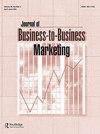B到B和B到C营销和销售自动化系统的发展
IF 2.5
4区 管理学
Q3 BUSINESS
引用次数: 0
摘要
摘要目的这篇观点文章考虑了信息和通信技术的最新发展对营销和销售自动化和支持的影响。它比较了企业对企业和企业对消费者市场的情况,并确定了两者之间的异同。它将这种情况与学术文献(主要是CRM系统、社交媒体和平台供应)中所涵盖的情况进行了比较,并确定了学术研究中的差距,目的是为在该领域进行研究或教学的学者以及深入参与该领域的从业者提供明确的指导。方法论该方法论是对学术和灰色文献以及概念分析的回顾,其中一人积极参与涉及营销和销售自动化的交付情况,另一人则为该领域的公司提供咨询。它借鉴了与领先公司从业者的讨论、贸易媒体、供应商案例研究以及领先营销传播机构与客户的经验,以确定最佳和正常的做法。讨论和咨询意见是保密的,因此不能参考。调查结果在信息技术发展的支持下,营销和销售活动的自动化进展迅速。对学术文献的回顾表明,学术界倾向于关注营销和销售自动化的特定方面,而不是领先公司所遵循的全面方法。重要的是,学术界要跟上这些发展,阅读专业文献,特别是与全面营销和销售自动化相关的文献,并与自动化方法的公司一起参与项目,特别关注那些旨在自动化整个营销和销售流程而不是其中单个部分的项目。实际意义在营销和销售自动化使用方面落后的公司应该考虑如何在其方法中全面而非零碎地体现这一点。这通常是通过审查公司的营销和销售流程,并与最佳实践进行比较(总体而非特定领域),然后与一个或多个营销和销售自动化系统和服务供应商接触,以确定自动化方法的好处及其实施路线图。研究意义学术界应该将研究项目纳入他们的职业计划,这将使他们直接接触营销和销售自动化的高级从业者,可能是通过案例研究而不是调查工作。这可能是通过与需要一些二级研究或培训的咨询公司合作实现的。本文章由计算机程序翻译,如有差异,请以英文原文为准。
Developments in B to B and B to C Marketing and Sales Automation Systems
ABSTRACT Purpose This viewpoint article considers the impact of the latest developments in information and communications technology on the automation of and support for marketing and sales. It compares the situation in business to business and business to consumer markets and identifies the similarities and differences between the two. It compares the situation with what is being covered in academic literature – mostly CRM systems, social media and platform supply – and identifies gaps in academic research – with the purpose of giving clear guidance for academics who are researching or teaching in this area, from practitioners who are involved deeply in the area. Methodology The methodology is a review of academic and gray literature and conceptual analysis, with a strong autoethnographic input from the, one of whom is actively involved in delivery situations involving marketing and sales automations and the other in advising companies in this area. It draws on discussions with practitioners in leading firms, on the trade press, supplier case studies and the experiences of a leading marketing communications agency with its clients to identify best and normal practice. The discussions and advisory input are confidential so cannot be referenced. Findings The automation of marketing and sales activity is progressing quickly, supported by developments in information technology. The review of academic literature shows that academics tend to focus on specific aspects of marketing and sales automation and not on the comprehensive approach followed by leading companies. It is important for academics to keep up with these developments, by reading the professional literature, particularly that relating to comprehensive marketing and sales automation, and by becoming involved in projects with companies that are automating their approaches, focusing particularly on projects which aim to automate the entire marketing and sales process rather than individual parts of it. Practical implications Companies which are falling behind in their use of marketing and sales automation should consider how to embody it in their approach, on a comprehensive rather than a piecemeal basis. This would normally be initiated by a review of the company’s marketing and sales processes and comparison with best practice (overall rather than in specific areas), and then engagement with one or more suppliers of marketing and sales automation systems and services, to identify the benefits of the automation approach and the roadmap to its implementation. Research implications Academics should build into their career plans research projects which will bring them into direct contact with advanced practitioners of marketing and sales automation, probably by case study rather than survey work. This might be through collaboration with consultancy firms which require some secondary research or training inoput.
求助全文
通过发布文献求助,成功后即可免费获取论文全文。
去求助
来源期刊
CiteScore
2.20
自引率
35.70%
发文量
22
期刊介绍:
The Journal of Business-to-Business Marketing® encourages diversity in approaches to business marketing theory development, research methods, and managerial problem solving. An editorial board comprised of outstanding, internationally recognized scholars and practitioners ensures that the journal maintains impeccable standards of relevance and rigorous scholarship. The Journal of Business-to-Business Marketing features: •basic and applied research that reflects current business marketing theory, methodology, and practice •articles from leading researchers covering topics of mutual interest for the business and academic communities

 求助内容:
求助内容: 应助结果提醒方式:
应助结果提醒方式:


